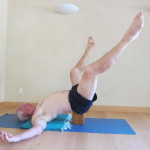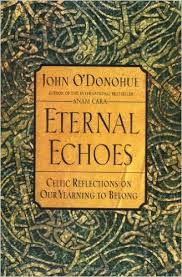 In our on going explorations in embodying Sacred Geometry, we continually cycle back to the torus, and the corresponding torroidal field, one of the primary patterns of cosmic creation. It is time to add a whole new level of torroidal intelligence to our somatic journey, and to do so, we will bring in my ‘across the street in Ojai’ neighbor Brian Berman, and what he is calling a HOLOS, a symbol for one humanity.
In our on going explorations in embodying Sacred Geometry, we continually cycle back to the torus, and the corresponding torroidal field, one of the primary patterns of cosmic creation. It is time to add a whole new level of torroidal intelligence to our somatic journey, and to do so, we will bring in my ‘across the street in Ojai’ neighbor Brian Berman, and what he is calling a HOLOS, a symbol for one humanity.
Brian, a spiritually awakened sculptor and peace activist, had an inspirational vision in 2012. It began as the illusion of his separate self dissolving into wholeness, emptiness and deep silence. Only Being/Knowing. Then a thought arose as a spark on energy that then dissolved back into the silence. Then another. Forms coming and going. Then, an image of a torus appeared, emerging from his heart as strands of energy spiraling out from stillness, and then spiraling back into the infinite stillness at the core of his heart. He recognized at once that the torus was a symbol of unity, of many linked as one, rooted in the infinite. From his many years as a peace activist, he realized the possibility of using this image as an international unifying symbol for all engaged in bringing peace to the world. And it did not hurt that, while on a 2014 pilgrimage to Ramana Maharshi’s ashram in Tiruvannamalai, India inquiring about using art in a spiritual way, he got a clear ‘bring this into the world’ message. 
The center of the Holos represents the infinite, wholeness, stillness and silence, the Source of all creation. The nine spirals represent the emergence of any and all forms, from atoms to galaxies, and everything in between. Think of the holos as a three dimensional expression of the pranavah, the sacred syllable ‘OM’. The nine spirals can be seen as linking three equilateral triangles, each of the 9 apices being 40 degrees apart on the circle. Nine is composed of a trinity of trinities. According to Michael Schneider in ‘The Beginners’ Guide to Constructing the Universe” “nine is considered thrice sacred and most holy, representing perfection, balance and order, the supreme superlative.”
 We are going to take this unique torus and use it to help clear out the chakras and invite it to provide an organizing intelligence for the water and collagen molecules in the Living Matrix of the body. Finding and differentiating the nine strands may take a while, but we are all in this for the long haul, so be patient. Consider this like the Vajrayana Buddhist practice of mandala visualization meditation. Much to be revealed in the future as we play with this!
We are going to take this unique torus and use it to help clear out the chakras and invite it to provide an organizing intelligence for the water and collagen molecules in the Living Matrix of the body. Finding and differentiating the nine strands may take a while, but we are all in this for the long haul, so be patient. Consider this like the Vajrayana Buddhist practice of mandala visualization meditation. Much to be revealed in the future as we play with this!
In any comfortable sitting pose, align yourself with heaven and earth and bring your attention to your heart center. Feel the spherical volume, above/below, front/back, right/left, alive, fluid, spacious. Now convert the sphere to a torus, opening the center like in a bagel, so now the center is emptiness. Stay open to heaven and earth and stillness  and begin to notice how the tissue in the heart region is responding. In the holos, ascending energies move clockwise and descending energies move counterclockwise. Let the field and your imagination do the work. Try not to help muscularly. Find where your energy field is weak or distorted, or overworking. (My right posterior quadrant is challenged). Now imagine the limbs differentiating, lengthening or spiraling to help create space. Visualize the empty space between the solid limbs of the holos. Feel it from above and below as in the very top picture. Try moving it around; up and down, right and left, forward and backward. What does this do to your feeling?
and begin to notice how the tissue in the heart region is responding. In the holos, ascending energies move clockwise and descending energies move counterclockwise. Let the field and your imagination do the work. Try not to help muscularly. Find where your energy field is weak or distorted, or overworking. (My right posterior quadrant is challenged). Now imagine the limbs differentiating, lengthening or spiraling to help create space. Visualize the empty space between the solid limbs of the holos. Feel it from above and below as in the very top picture. Try moving it around; up and down, right and left, forward and backward. What does this do to your feeling?
If we combine the holos with a hoberman sphere, we can expand and condense both the empty center space, as well as the nine spiraling lines, in a gyroscope like action. This action really awakens new  possibilities in the holos. Feel how the centrifugal expansion increase space between the lines as they rotate outward. Feel the spirals rippling through the fluids and tissues as the chakra line stabilizes. Same with condensing centripetal action. For most of us, the heart space (prana vayu) needs more expanding and the belly space (apana) needs more condensing.
possibilities in the holos. Feel how the centrifugal expansion increase space between the lines as they rotate outward. Feel the spirals rippling through the fluids and tissues as the chakra line stabilizes. Same with condensing centripetal action. For most of us, the heart space (prana vayu) needs more expanding and the belly space (apana) needs more condensing.
The well known sacred geometer extraordinaire, B.K.S. Iyengar, (how many different triangles can you find in this trikonasana?) describes this phenomenon in “Light on the Yoga Sutras of Patanjali”, in his commentary to sutra II-46: “Conative action is the exertion of the organs of action. Cognitive action is the perception of the results of that action. When the two are fused together, the discriminative faculty of the mind acts to guide the organs of action and perception to perform the asans more correctly; the rhythmic flow of energy and awareness is experienced evenly and without interruption, both centripetally and centrifugally throughout the channels of the body. A pure state of joy is felt in the cells and the mind. (For a deeper discussion of this, see Samyama in Asana.)
the mind acts to guide the organs of action and perception to perform the asans more correctly; the rhythmic flow of energy and awareness is experienced evenly and without interruption, both centripetally and centrifugally throughout the channels of the body. A pure state of joy is felt in the cells and the mind. (For a deeper discussion of this, see Samyama in Asana.)
The holos field is a fractal, so it can be found all over the body. Imagine it to help to open any place that feels restricted. Take it into your limbs, head and tail until it finds its place. The center is always stillness and the energies emerge and dissolve again and again, moment to moment, day by day. Take time to help the larger field and the mini fields also, stabilize. Find the patterns in any pose, at any time. Let them settle and stabilize. No hurry, no worries.
Take it into your limbs, head and tail until it finds its place. The center is always stillness and the energies emerge and dissolve again and again, moment to moment, day by day. Take time to help the larger field and the mini fields also, stabilize. Find the patterns in any pose, at any time. Let them settle and stabilize. No hurry, no worries.







